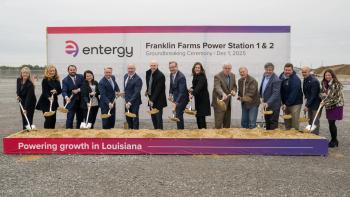
The Gas-Solar Alliance
This year's Solar Power International show in Dallas featured a panel promoting
the value of the solar and gas industries working together to their mutual
advantage. By 2015, analysts are predicting that another 140 GW of solar
capacity will come onto the grid. In the same time frame, natural gas should
bring on another 314 GW of capacity. If the estimate is correct, that will mean
gas accounts for 40 percent of the U.S. total while Solar reaches 20 percent.
Peter Evans, director of global strategy and planning for GE
Energy said, "Both solar and gas can deal with a centralized or distributed model so they are a good match. And gas flexibility fits in well with solar intermittency."
Peter gave the example of a large Centralized Photo Voltaic (CPV) facility. On its
own, the spikes and troughs in output level could stress the grid. By building
it close to a flexible combined cycle power plant (CCPP) that can ramp up or down
rapidly, the swings in CPV production could be absorbed. This would also work,
said Evans, with rooftop PV. In that case, micro-turbines and smaller gas
turbines would be harnessed. He felt this was a far cheaper option than existing
storage alternatives such as Compressed Air Energy Storage (CAES) or batteries.
Pearce Hammond, an analyst with Simmons & Company, International, explained how
the gas market impacts the solar sector. He said, "Natural gas sets the price of electricity in the USA and thus is a huge driver of solar. If the price of gas is higher, that is good news for
solar economics as it makes solar plants more viable."
Gas prices, of course, are low and expected to stay there for a while due to
the shale gas boom. That is creating a build out in gas pipelines, LNG
facilities and ethane crackers on U.S. soil. Over time, though, Hammond predicts
gas prices will rise somewhat as its usage rates climb in the face of high crude
oil values.
Newsletter
Power your knowledge with the latest in turbine technology, engineering advances, and energy solutions—subscribe to Turbomachinery International today.





